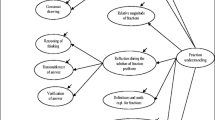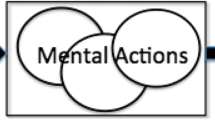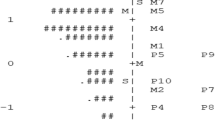Abstract
Teaching and learning fractions has traditionally been one of the most problematic areas in primary school mathematics. Several studies have suggested that one of the main factors contributing to this complexity is that fractions comprise a multifaceted notion encompassing five interrelated subconstructs (i.e., part-whole, ratio, operator, quotient, and measure). Kieren was the first to establish that the concept of fractions is not a single construct, but consists of several interrelated subconstructs. Later on, in the early 1980s, Behr et al. built on Kieren’s conceptualization and suggested a theoretical model linking the five subconstructs of fractions to the operations of fractions, fraction equivalence, and problem solving. In the present study we used this theoretical model as a reference point to investigate students’ constructions of the different subconstructs of fractions. In particular, using structural equation modeling techniques to analyze data of 646 fifth and sixth graders’ performance on fractions, we examined the associations among the different subconstructs of fractions as well as the extent to which these subconstructs explain students’ performance on fraction operations and fraction equivalence. To a great extent, the data provided support to the associations included in the model, although, they also suggested some additional associations between the notions of the model. We discuss these findings taking into consideration the context in which the study was conducted and we provide implications for the teaching of fractions and suggestions for further research.
Similar content being viewed by others
References
Baturo, A.R.: 2004, ‘Empowering Andrea to help year 5 students construct fraction understanding,’ Proceedings of the 28th PME Conference, Vol. 2, Bergen University College, Bergen, pp. 95–102.
Behr, M.J., Harel, G., Post, T. and Lesh, R.: 1993, ‘Rational numbers: Toward a semantic analysis-emphasis on the operator construct,’ in T.P. Carpenter, E. Fennema and T.A. Romberg (eds.), Rational Numbers: An Integration of Research, Lawrence Erlbaum Associates, New Jersey, pp. 13–47.
Behr, M., Lesh, R., Post, T. and Silver, E.: 1983, ‘Rational number concepts,’ in R. Lesh and M. Landau (eds.), Acquisition of Mathematics Concepts and Processes, Academic Press, New York, pp. 91–125.
Bentler, P.M.: 1995, EQS: Structural equations program manual, Multivariate software inc, California.
Boulet, G.: 1998, ‘Didactical implications of children’s difficulties in learning the fraction concept,’ Focus on Learning Problems in Mathematics 20(4), 19–34.
Brainerd, C.J.: 1978: ‘The stage question in cognitive developmental theory,’ The Behavioral and Brain Sciences 2, 173–213.
Brousseau, G., Brousseau, N. and Warfield, V.: 2004, ‘Rationals and decimals as required in the school curriculum. Part 1: Rationals as measurements,’ Journal of Mathematical Behavior 23, 1–20.
Brown, J.S., Collins, A. and Duguid, P.: 1989, ‘Situated cognition in the culture of learning,’ Educational Researcher 18, 32–42.
Carpenter, T.P., Fennema, E. and Romberg, T.A.: 1993, ‘Toward a unified discipline of scientific inquiry,’ in T.P. Carpenter, E. Fennema and T.A. Romberg (eds.), Rational Numbers: An Integration of Research, Lawrence Erlbaum Associates, New Jersey, pp. 1–11.
Carraher, D.W.: 1996, ‘Learning about fractions,’ in L.P. Steffe, P. Nesher, P. Cobb, G.A. Goldin and B. Greer (eds.), Theories of Mathematical Learning, Lawrence Erlbaum Associates, New Jersey, pp. 241–266.
Cramer, K.A., Post, T.R. and del Mas, R.C.: 2002, ‘Initial fraction learning by fourth- and fifth-grade students: A comparison of the effects of using commercial curricula with the effects of using the rational number project curriculum,’ Journal for Research in Mathematics Education 33(2), 111–144.
Davis, G., Hunting, R.P. and Pearn, C.: 1993, ‘What might a fraction mean to a child and how would a teacher know?,’ The Journal of Mathematical Behaviour 12(1), 63–76.
Hannula, M.S.: 2003, ‘Locating fraction on a number line,’ in N.A. Pateman, B.J. Dougherty and J. Zilliox (eds.), Proceedings of the 2003 Joint Meeting of the PME and PMENA, Vol. 3, CRDG, College of Education, University of Hawaii, Hawaii, pp. 17–24.
Hu, L. and Bentler, P.M.: 1999, ‘Cutoff criteria for fit indexes in covariance structure analysis: Conventional criteria versus new alternatives,’ Structural Equation Modeling 6(1), 1–55.
Keijzer, R. and Terwel, J.: 2003, ‘Learning for mathematical insight: a longitudinal comparative study on modeling,’ Learning and Instruction 13, 285–304.
Kieren, T.E.: 1993, ‘Rational and fractional numbers: From quotient fields to recursive understanding,’ in T.P. Carpenter, E. Fennema and T.A. Romberg (eds.), Rational Numbers: An Integration of Research, Lawrence Erlbaum Associates, NJ, pp. 49–84.
Kieren, T.E.: 1976, ‘On the mathematical, cognitive, and instructional foundations of rational numbers,’ in R. Lesh (ed.), Number and Measurement: Papers from a Research Workshop ERIC/SMEAC, Columbus, OH, pp. 101–144.
Kline, R.B.: 1998, Principles and Practice of Structural Equation Modeling, The Guilford Press, New York.
Kyriakides, L. and Charalambous, C.: 2002, ‘Developmental assessment of primary students’ Skills on multiple representations: Construct validity of a test on fractions,’ Mediterranean Journal for Research in Mathematics Education 1(1), 79–104.
Lamon, S.L.: 2001, ‘Presenting and representing: From fractions to rational numbers,’ in A. Cuoco and F. Curcio (eds.), The Roles of Representations in School Mathematics-2001 Yearbook, Reston: NCTM, pp. 146–165.
Lamon, S.J.: 1999, Teaching Fractions and Ratios for Understanding, Lawrence Erlbaum Associates, New Jersey.
Lamon, S.J.: 1993, ‘Ratio and proportion: Children’s cognitive and metacognitive process,’ in T.P. Carpenter, E. Fennema and T.A. Romberg (eds.), Rational Numbers: An Integration of Research, Lawrence Erlbaum Associates, New Jersey, pp. 131–156.
Lave, J. and Wenger, E.: 1991, Situated Learning: Legitimate Peripheral Participation, Cambridge University Press, New York.
Marshall, S.P.: 1993, ‘Assessment of rational number understanding: A schema-based approach,’ in T.P. Carpenter, E. Fennema and T.A. Romberg (eds.), Rational Numbers: An Integration of Research, Lawrence Erlbaum Associates, New Jersey, pp. 261–288.
Ni, Y.: 2001, ‘Semantic domains of rational numbers and the acquisition of fraction equivalence,’ Contemporary Educational Psychology 26, 400–417.
Noelting, G.: 1978, ‘The development of proportional reasoning in the child and adolescent through combination of logic and arithmetic,’ Proceedings of the Second PME Conference, University of Osnabruck, West Germany, pp. 242–277.
Olive, J. and Lobato, J.: in press, ‘The learning of rational number concepts using technology,’ in K. Heid and G. Blume (eds.), Research on technology in the teaching and learning of mathematics: syntheses and perspectives, Information Age Publishing, Greenwich.
Philippou, G. and Christou, C.: 1994, ‘Prospective elementary teachers’ Conceptual and procedural knowledge of fractions,’ Proceedings of the 18th PME Conference, Vol. 4, University of Lisbon, Lisbon, pp. 33–40.
Smith, J.P.: 2002, ‘The development of students’ knowledge of fractions and ratios,’ in B. Litwiller and G. Bright (eds.), Making Sense of Fractions, Ratios, and Proportions, Reston, Virginia, NCTM, pp. 3–17.
Stafylidou, S. and Vosniadou, S.: 2004, ‘The development of students’ understanding of the numerical value of fraction,’ Learning and Instruction 14(5), 503–518.
Streefland, L.: 1993, ‘Fractions: A realistic approach’, in T.P. Carpenter, E. Fennema, and T.A. Romberg (eds.), Rational Numbers: An integration of research, Lawrence Erlbaum Associates, New Jersey, pp. 289–325.
Streefland, L.: 1991, Fractions in Realistic Mathematics Education: A Paradigm of Developmental Research (R. Rainero et al., Trans.), Kluwer Academic Publishers, The Netherlands.
Author information
Authors and Affiliations
Corresponding author
Rights and permissions
About this article
Cite this article
Charalambous, C.Y., Pitta-Pantazi, D. Drawing on a Theoretical Model to Study Students’ Understandings of Fractions. Educ Stud Math 64, 293–316 (2007). https://doi.org/10.1007/s10649-006-9036-2
Received:
Accepted:
Published:
Issue Date:
DOI: https://doi.org/10.1007/s10649-006-9036-2




